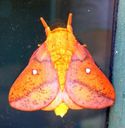Anisota
Anisota
Classification
- Phylum: Arthropoda
- Subphylum: Hexapoda
- Class: Insecta
- Order: Lepidoptera
- Superfamily: Bombycoidea
- Family: Saturniidae
- Subfamily: Ceratocampinae
- Genus: Anisota
Pronunciation
How to pronounce Anisota: //æˈnɪsətə//
These audio files are automatically generated. While they are not always 100% accurate, they are a good starting point.
Images






Summary
Anisota is a genus of moths in the family Saturniidae, known as oakworms during their larval stage. They are significant defoliators of oak trees and exhibit various life cycles and reproductive behaviors, with species that differ in appearance and habitat preference. The genus includes several notable species such as A. stigma, A. senatoria, and A. virginiensis, each with unique identifying features.
Physical Characteristics
Wingspan circa 4-7 cm; males have partly transparent wings with a white spot and are day-flying, while females are mostly nocturnal. Caterpillars exhibit various color patterns including orange/pink stripes, black with yellow/orange stripes, or pink stripes depending on the species.
Identification Tips
Males can be found at lights, particularly A. stigma. Look for distinct wing patterns: A. senatoria has black spots, A. virginiensis has purple margins with no black spots.
Habitat
Deciduous forests and woodlands with oaks.
Distribution
Eastern North America, with some species isolated in northern and southwestern areas.
Diet
Larvae feed on leaves of oaks, with host plants including Chinkapin Oak (Quercus muehlenbergii) and Chestnut Oak (Quercus prinus).
Life Cycle
Life cycle includes male flight during the day searching for females. Eggs are laid in clusters of 15-150, with some species having one or two flights per year depending on the region.
Reproduction
Mating typically occurs during the day for most males and at night for females, who oviposit at night.
Predators
Information not provided.
Conservation Status
Information not provided.
Ecosystem Role
Defoliators of oaks, contributing to the ecosystem by affecting tree health and dynamics.
Economic Impact
Information not provided.
Cultural Significance
Information not provided.
Health Concerns
Information not provided.
Collecting Methods
- Light trapping for adults
- Searching host plants for larvae
Preservation Methods
- Pinning for adult moths
- Storing larvae in containers with host plant material
Evolution
Taxonomic history includes considerable shuffling, with some species treated as distinct despite uncertainties in their classification.
Similar Taxa
Misconceptions
Some males are not typically found at lights, which can lead to confusion in identification between species.
Tags
- moths
- Lepidoptera
- Saturniidae
- oakworms
- Anisota